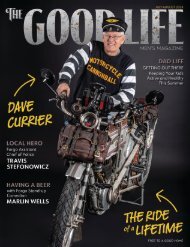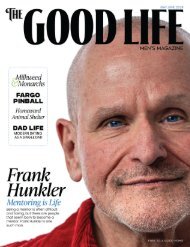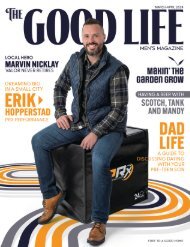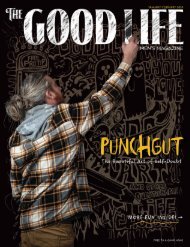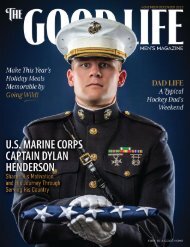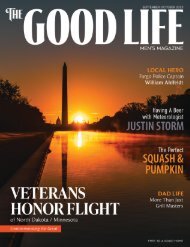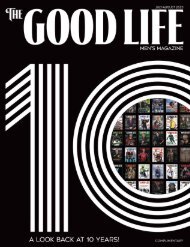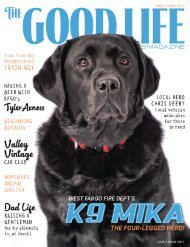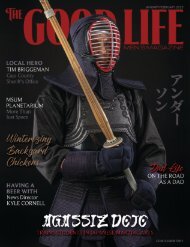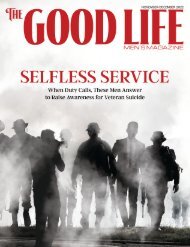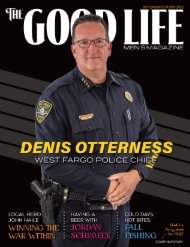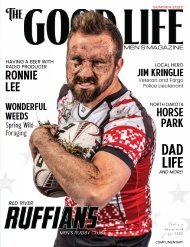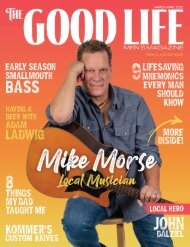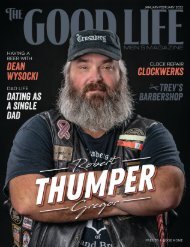The Good Life – March-April 2020
On the cover, Than Baardson. Local Hero, US Marine Corps Veteran Wayne Casebeer, Having a Beer with Moorhead Mayor Johnathan Judd and more in Fargo Moorhead's only men's magazine.
On the cover, Than Baardson. Local Hero, US Marine Corps Veteran Wayne Casebeer, Having a Beer with Moorhead Mayor Johnathan Judd and more in Fargo Moorhead's only men's magazine.
You also want an ePaper? Increase the reach of your titles
YUMPU automatically turns print PDFs into web optimized ePapers that Google loves.
FATHERS | MR. FULL-TIME DAD
MR. FULL-TIME DAD 2.0
Dusting Off the Baby on Board Sticker
WRITTEN BY: BEN HANSON • PHOTO BY: URBAN TOAD MEDIA
For the regular readers of this column (hi Mom and Dad!),
the following announcement will come as no surprise by
the time this edition of “The Good Life” hits the stands.
Nevertheless, I have news: Macklin is getting a baby brother
sometime mid-summer. My apologies to the relatives and
in-laws who are just now finding out… I only had so much
patience for actual phone calls.
That’s right, folks, Mr. Full-Time Dad rides again in 2020!
It’s time to put the crib back together (hopefully just once
this time), dig out the onesies and wash some bottles —
life’s about to hurry up and slow way down, as I make
the transition back to my all-time favorite role as primary
caregiver.
Much has changed since “The Mack and Daddy Show”
debuted during the holiday season of 2015. Mack’s now
in full-time preschool, I’ve come out of early retirement
and we’re in a new house in a new neighborhood full of
unexplored parks and paths. My reaction to the positive
pregnancy test also changed… I did not go mute and there
were no tears of dread. I’m not sure who’s matured more,
me or Mack.
Some things, though, have remained the same in regards
to baby #2. My wife, Emily, and I put in as much, if not more
time contemplating the decision. We’re not ones to rush
into anything. It took us years to convince ourselves we
were ready for parenthood, and my borderline meltdown
of a reaction to the news then shows just how unprepared I
still felt. While I have settled the debate about my parenting
skills (in my mind, at least), deciding to try for a second
presented a whole new batch of questions.
Are we pushing our luck?
Macklin was a great baby. He started sleeping through the
night within weeks, almost never got sick, rarely threw up
and basically put himself to sleep whenever you laid him
down in his crib. As a toddler, he was a delight. His sense
of humor came out quick, he relished spending time with
mom and dad and adapted quickly to whatever changes
came along. Now, as a preschooler, he’s becoming an
absolutely beautiful human being. His vocabulary is rich
(thanks, NPR), his social skills are impressive and his daily
display of empathy is a constant source of pride.
In short, we’ve been blessed. Overwhelmingly so. Naturally,
my inclination towards pessimism constantly shouted
the question in my brain: are we pushing our luck if we
try for two? It’s hard for me to imagine a better parenting
experience than the one Mack has given us… so what’s
going to happen if our second child somehow doesn’t
match up?
I know that’s saying the quiet part out loud and it’s a
horrible thought to have to reckon with, but it’s the truth.
Overcoming that “what if” fear was hard for me, and if I’m
being honest I’m still not completely over it. But fear is a
lousy reason not to try.
2 / THE GOOD LIFE / urbantoadmedia.com
Are we getting greedy?
Because of everything I outlined above, I also struggled
with the idea of simply being content and thankful for
what we already have. Being a father to Macklin has
made me a better person. It has brought my wife and
I closer together as a couple. It’s made my extended
family relationships stronger, too. So, as one who is
well aware of his privilege, I wrestled with the idea that
we needed anything more.
But it’s not all about me (shocking). The more Emily and
I pondered this question, the more our conversations
shifted to Macklin. We decided he should get the
opportunity to have a sibling, and selfishly both Emily
and I are more than eager to watch him grow into
his new role as a big brother. When approaching the
decision from that perspective, the choice was easy. And
now, when those fears and doubts re-enter my mind, I
am comforted by future scenes of Mack teaching his
little brother how to play his latest made-up game.
We’re not “trying again”
I really dislike that question: “oh, you’re trying again?”
No, we’re not trying again. Firstborns are not an
experiment, and their siblings are not a redo. While it
may sound like I’m hoping for a Macklin clone, I am
not. I’d be lying if I said I wasn’t hoping for another
carefree infant, joyful toddler and kind young man, but
these are the wishes of every expecting parent.
I’m sure there will be comparisons made between
Mack and his brother. It’s inevitable. Human nature is
to judge, and I’m as guilty as the next. Luckily, the most
likely comparison I’ll make will be to decide which kid
has the better sense of humor… I mean, how else would
you suggest I pick my favorite? •
urbantoadmedia.com / THE GOOD LIFE / 3
2
6
8
12
14
18
28
30
FATHERS
MR. FULL-TIME DAD 2.0
Dusting Off the Baby on
Board Sticker
IN THE PRESENCE OF
TREES
NORTH DAKOTA SWEET CRUDE
PROVES THINGS CAN GET
BETTER WITH TIME
RX FOR A HEALTHY
RELATIONSHIP
(RELAX, IT'S NOT
COMPLICATED)
HAVING A BEER WITH
MOORHEAD MAYOR
JOHNATHAN JUDD
ON THE COVER -
THAN BAARDSON
FUELING A RIGHTEOUS FIRE
Local Nonprofit Fights for
the 'Unseen'
ASK 30 WOMEN
WHAT IS ONE THING HE SAYS,
OR AN EXPRESSION HE USES
THAT MAKES YOU CRINGE?
LOCAL HERO -
WAYNE CASEBEER
LEADING QUIETLY,
RESPONSIBLY,
AND SINCERELY
4 / THE GOOD LIFE / urbantoadmedia.com
The
GOODLIFE
MEN’S MAGAZINE
PUBLISHED BY
Urban Toad Media LLP
www.urbantoadmedia.com
OWNER / PHOTOGRAPHER
Darren Losee
darren@urbantoadmedia.com
OWNER / GRAPHIC DESIGNER
Dawn Siewert
dawn@urbantoadmedia.com
CONTRIBUTING WRITERS
Meghan Feir
Alexandra Floersch
Ben Hanson
Katie Jenison
Jeffrey Miller
Krissy Ness
Alexis Swenson
ADVERTISING INQUIRIES
Darren Losee
darren@urbantoadmedia.com
READ A PAST ISSUE
yumpu.com/user/thegoodlife
FOLLOW US ON FACEBOOK
facebook.com/urbantoadmedia
FOLLOW US ON TWITTER
@urbantoadmedia
FOLLOW US ON INSTAGRAM
@urbantoadmedia
The Good Life Men’s Magazine is distributed six times
a year by Urban Toad Media LLP. Material may not be
reproduced without permission. The Good Life Men’s
Magazine accepts no liability for reader dissatisfaction
arising from content in this publication. The opinions
expressed, or advice given, are the views of individual
writers or advertisers and do not necessarily represent
the views or policies of The Good Life Men’s Magazine.
urbantoadmedia.com / THE GOOD LIFE / 5
The Presence of Trees
TREES
WRITTEN BY: JEFFREY MILLER
The flutter of leaves in a warm summer breeze. Upright sentinels stopping arctic
windblown snow. A snug place for a raccoon to raise her litter. Cool shade at the
lake place. Trees are many different things to different people, but one thing is
certain. We need trees.
Pre-settlement, the landscape around Fargo looked much different. Tall
grass prairie stretched to the horizon. The only trees on the landscape
grew in the riparian zones. Riparian zones are areas around water,
such as lakes, rivers and ponds. Along the Red and Sheyenne
Rivers in particular, a variety of native trees grew to great heights.
Bur oak, cottonwood, American linden, boxelder, American elm,
among others, stood in stark contrast to the prairie grasses that
dominated the landscape.
In the modern day, cropland has replaced much of the prairie,
and towns and cities dot the landscape. Impervious surfaces,
such as concrete and homes, allow for rainwater and snowmelt
to rush towards the rivers and streams, carrying contaminants and
pollutants. In modern urban life, is there any room for conservation?
The answer to that question is a resounding YES! While large-scale
conservation efforts are more obvious, even the smallest of efforts can
have a big impact.
Trees are many different
things to different people,
but one thing is certain.
We need trees.
Urban areas benefit greatly by the presence of trees. Typical turfgrass lawns,
without trees, soak up very little rainfall. Even one mature tree in a yard will use
thousands of gallons of water each year. The graceful arching branches provide
cooling shade for homes and businesses. Particulate matter air pollution can
be reduced by trees growing in urban areas. Some species of trees can even
provide fresh fruit.
Arguably, more importantly, trees provide a touchstone for nature. Beyond the
swirl of traffic, the crush of humanity, and the sterility of turfgrass, trees lend a
glimmer of the natural world. Urban wildlife, from birds to squirrels to microorganisms
and fungus make their home in and on trees. Studies have shown that
6 / THE GOOD LIFE / urbantoadmedia.com
homes and businesses with trees and
shrubs are, on average, more appealing
to buyers. A recent study at Australia's
University of Wollongong revealed that
30% or more total green space, that
included tree canopy, was associated
with 31% lower rates of psychological
distress. The natural colors, shapes,
aromas and sounds of a tree or urban
forest provide distraction and relief
from daily stresses. The Japanese even
have a term for it. Shinrin-yoku, or
forest bathing, is the practice of taking
in the forest through our senses. As a
recent study from the Environmental
Protection Agency has shown, the
average American spends 93% of their
time indoors.
Soil Conservation Districts in
North Dakota and Soil and Water
Conservation Districts in Minnesota
sell bare-root conservation-grade trees
and shrub seedlings that are lowcost
alternatives to large landscape
trees. In addition, technical advice
and planning are free. Staff, such as
Programs Manager Tony Peterson at
the Cass County Soil Conservation
District, are trained and experienced in
evaluating each location to determine
the best species of tree to plant. Every
tree species grows best in specific
soils, and it's important to match the
species to the soil. With informed
recommendations and guidance, tree
planting failures can be avoided.
A wide variety of native and introduced
tree and shrubs species can be grown
in Fargo-Moorhead. Species such
as Scotch Pine, Black Hills Spruce,
Nanking Cherry, Ohio Buckeye, and
Silver Maple aren't native species but
grow well in our soils. Native species
such as Bur Oak, Native Cottonwood,
American Linden and Boxelder will
also lend beauty to any property. The
old axiom of "think global, act local"
applies well to trees. Planting just a
few trees provides huge benefits for
everyone. •
Shinrin-yoku,
or forest bathing, is the
practice of taking in the
forest through our senses.
urbantoadmedia.com / THE GOOD LIFE / 7
NORTH DAKOTA SWEET CRUDE
Proves Things Get Better With Time
WRITTEN BY: KATIE JENISON
PHOTOS BY: URBAN TOAD MEDIA
How this 100-year-old
recipe is taking North
Dakota by storm
With an abundance of existing and
new bars opening in the Fargo-
Moorhead region, it’s hard to believe
North Dakota was a dry state less
than a century ago. Yet, it’s true.
Prohibition began in North Dakota
in 1889, the same year the state
was admitted to the United States.
Though a ban on alcohol was
enacted, it didn’t stop North Dakota
residents from getting their hands
on the alcohol of their choice. Those
close to the border simply crossed
the Red River into Minnesota to
imbibe. Others in central parts of
the state took matters into their
own hands by distilling their own
moonshine.
That’s how North Dakota Sweet
Crude first came to be. It goes by
many names—red-eye, burnt sugar
whiskey, apple pie—but Art Weidner
and his family prefer to call it
wedding whiskey. The 100-year-old
recipe was created by Art’s great
grandfather, Martin Weidner, in Zap,
North Dakota. Since its inception,
the recipe has been handed down
for generations with Martin passing
it on to his son, Albert, and so on.
Each generation of Weidners made
their own tweaks to the recipe, but
for the most part, it’s stayed true to
the original.
8 / THE GOOD LIFE / urbantoadmedia.com
It goes by many names
red-eye,
burnt sugar
whiskey,
apple pie –
but Art Weidner and his
family prefer to call it
wedding whiskey.
urbantoadmedia.com / THE GOOD LIFE / 9
The ultra-smooth liqueur has
a distinct taste of cinnamon
before it mellows with notes of
ginger and lemongrass.
The 75 proof beverage has the look
and feel of whiskey, but is technically
a sweet liqueur. At first sip, the ultrasmooth
liqueur has a distinct taste
of cinnamon before it mellows with
notes of ginger and lemongrass. Art
and his brother Christian learned to
make Martin Weidner’s smokehouse
whiskey from their dad, the Rev.
Arthur Weidner. He taught them
the recipe in the family kitchen,
where they’d make small batches
on the stove. His dad jokes that
Grandpa Albert used to take a shot
every morning before milking the
cows because “it aids in digestion.”
Whether you believe in its digestive
benefits or not, there’s no denying
the recipe has been a big hit.
In addition to enjoying it at family
celebrations, the Weidner brothers
would gift bottles to farmers as a
thank you for letting them hunt on
their land. After receiving many
requests for more bottles each year,
the brothers thought they might be
on to something. Art began putting
things into motion and eventually
launched his company, Doodlebug
Beverages.
But what makes North Dakota
Sweet Crude different from other
liqueurs? Aside from the rich history
behind the product, the ingredients
Art uses make all the difference.
North Dakota Sweet Crude uses
natural ingredients to achieve its
distinct flavor. Most notably is the
use of caramelized sugar, which
comes from beets harvested in the
Red River Valley.
Similar products on the market
use caramelized sugar primarily as
a colorant. In contrast, Doodlebug
Beverages uses it to enhance the
flavor profile of North Dakota Sweet
Crude. In fact, caramelized sugar
is central to its flavor profile. The
ingredient is so crucial that it was
one of the biggest obstacles that Art
faced bringing North Dakota Sweet
Crude to the masses.
To use caramelized sugar in the
recipe, Art had to find a way to
produce it in large quantities. So
the brothers, who graduated from
North Dakota State University with
degrees in Mechanical Engineering,
put their heads together to come up
with a solution. With a plan in place,
the two pitched their idea to NDSU
and were awarded a partial grant
to develop the equipment. After
about three years and a few hiccups
along the way, they perfected the
machinery.
10 / THE GOOD LIFE / urbantoadmedia.com
PHOTO SUBMITTED BY: ART WEIDNER
The next step was finding someone to distill the product.
Art employed the help of Chris Montana, president of
the American Craft Spirit Association and owner of
Minnesota’s Du Nord Craft Spirits. The partnership
has proven to be the dream team Doodlebug Beverages
needed. Art and Montana fine-tuned the process to
ensure North Dakota Sweet Crude is distilled just as
it was over 100 years ago—and it’s safe to say Great
Grandpa Weidner would be proud!
The first batch of North Dakota Sweet Crude hit shelves
in July of 2018 and has quickly become a favorite
among North Dakotans. Almost 500 locations in North
Dakota sell the liqueur, and Art has started expanding
distribution to Minnesota and South Dakota. As for the
best way to drink it, well, that’s up for debate. While
many, including Art, keep it simple by drinking the sweet
brown liqueur on the rocks, others like to get creative.
Some of the most popular drink recipes include the
Dakota sweet lemonade and the Dakota mule, which
can be found on Art’s website, crudespirits.com.
With the massive success of Doodlebug Beverage’s
flagship product, Art is already looking to the future. In
addition to continuing to expand distribution of North
Dakota Sweet Crude, he has a few new product ideas on
tap. He plans to introduce a new recipe that leads with
notes of citrus. Regardless of what the future holds, Art
will be living his version of the good life: traveling rural
parts of the state and introducing people to a true North
Dakota recipe. •
urbantoadmedia.com / THE GOOD LIFE / 11
MEN'S HEALTH
Rx for A Healthy Relationship
(Relax, It’s Not Complicated)
Maintaining healthy relationships
is important not just for our mental
and spiritual health, but also
for our physical health.
WRITTEN BY: BEN HANSON
Now that Valentine's Day has come and gone, we thought
it'd be a good time to talk about relationships. Sure, you
might be wondering why such valuable advice wasn't doled
out prior to the "most romantic day of the year," and that's
an entirely fair question. Well, guess what? The ol' editorial
calendar can be as perplexing a game as love, so maybe just
be happy with what you get when you get it. Get it?
The truth is it doesn't much matter what time of year it is. All
of us — men and women — could stand to spend a bit more
time thinking, contemplating and acting on the things that
make our relationships thrive, all the while trying to dodge
and weave the inevitable challenges that inevitably spring
up… often with little notice (although, if you never see it
coming, the odds of "it" being your fault are embarrassingly
high).
Maintaining healthy relationships is important not just for
our mental and spiritual health, but also for our physical
health. If you're suffering in a bad relationship, you're quite
literally suffering, and that suffering can manifest itself in
a variety of ways: stress, unhealthy eating and drinking
habits, increased risk for serious health conditions like high
blood pressure, high cholesterol and even heart disease.
The relative health of your romantic relationship in many
ways can be an insightful window into your overall health
and well-being.
Now's probably a good time to clearly state that I am not
a relationship expert, and this piece is in no way intended
to replace a good hour or two on a therapist's couch. In
fact, that bit about avoiding challenges… though it sounds
right… couldn't be more wrong. Let's bring in the doc to help
explain why.
Communication Above All Else
"Mastering communication is huge. It's probably the single
most important indicator of a healthy relationship," says Dr.
Forrest Sauer, founder of Twin Oaks Health Solutions in
Fargo. "If you're in the habit of avoiding conflict, burying
your feelings and not addressing the problem as soon as
it becomes apparent, you're relationship is going to suffer
and never reach its full potential. It's hard to master
communication because it requires so much vulnerability,
12 / THE GOOD LIFE / urbantoadmedia.com
but the rewards are well worth the initial discomfort of
opening up fully to your partner."
The benefits of strong communication are plentiful and
mostly obvious, but Dr. Sauer highlighted one perk that
could easily fly under the radar. He says when you're open
and honest with your partner and willing to share what's
on your mind, what's important to you and what support
you may need, it frees you up to enjoy the rest of your life
outside of your romantic relationship… specifically, your
friendships that matter every bit as much to your overall
well-being.
"If you get your relationship with your significant other
to a point where you understand each other's need for
personal space when needed," Dr. Sauer say "if that
communication is strong enough, then you're going to
have the time and be able to nurture your friendships
outside of your romantic relationship. Most of us are
social creatures to a certain extent, and it's in our best
interest to take care of all of our personal relationships."
Just Pay Attention
I was reminded of the classic "Simpsons" character
Troy McLure and his motivational films, such as "Get
Confident, Stupid!" and "Lead Paint: Delicious But
Deadly," when Dr. Sauer casually mentioned the most
basic first step anyone can take to develop a healthy
relationship… and that is simply to pay attention (stupid).
This particular piece of advice hit close to home with me,
as it perfectly sums up my approach to parenting, another
type of relationship that requires a lot of nurturing. In
both instances, paying attention is really the only way
you'll ever learn how your partner (or friend, coworker,
child, etc.) prefers to communicate. That's not to say
you have to adopt your partner's communication style;
it just means pay attention to the cues they give so you
can respond at the appropriate time with the appropriate
message and appropriate tone.
"Case in point," Dr. Sauer begins. "A couple of weeks ago,
I had been working a lot, didn't have a whole lot of time
to relax and even less time to myself. Because my wife
and I work hard on maintaining open communication
and we've learned how best to speak to each other, it was
easy for me to just ask her if she'd be willing to take the
kids on her errands so I could have an hour or two of
downtime to re-energize. She was more than willing to
accommodate me, as she trusts that when she needs that
time I'll be happy to reciprocate."
So, to recap: pay attention, don't be afraid to confront the
challenges and let yourself be vulnerable enough to say
what needs to be said and ask for what you need. You've
got a year until next Valentine's. Good luck. •
Special thanks to Dr. Forrest Sauer at Twin Oaks Health Solutions,
medical consultant for our Men’s Health section.
urbantoadmedia.com / THE GOOD LIFE / 13
HAVING A BEER WITH | MAYOR JUDD
WRITTEN BY: MEGHAN FEIR • PHOTOS BY: URBAN TOAD MEDIA
While most native Midwesterners woefully threaten to
move south due to the long, drawn-out and brutal winters,
the mayor of Moorhead, Minn., is thankful for the cooler
temperatures. Originally from Raleigh, N.C., Johnathan Judd
moved to North Dakota and began attending Fargo North as
a senior in high school to live with his best friend’s family
and experience something new for a year.
It’s been 28 years since he made that decision, and he hasn’t
looked back. With a wife, three kids, friends and a successful
career as mayor and M-State’s new director of equity and
inclusion, it’s clear his roots have grown deep into the
Minnesota soil.
We sat down in Drekker’s Brewhalla for a little chat and a
brew as he told me more about the direction his life has
taken, from poverty to opportunity. Read on to learn more
about Moorhead’s mayor.
14 / THE GOOD LIFE / urbantoadmedia.com
Good Life: What have you thought of this area since
moving up here? Obviously, it’s extremely different
climate-wise, the terrain—everything.
Johnathan Judd: The people. When I went to Fargo
North my senior year, the families were awesome and
just welcomed me. I felt like I was home. Obviously, it
took time to adjust, but the people helped build me up
to where I am today. That’s why I stayed. And I hate hot
weather. I’d rather be cold than hot.
GL: Did you ever think you’d get into politics?
JJ: I always thought I’d work in a campaign, like as a
strategist or something, but as the actual candidate, no.
Although my aunt tells me I said at some point that I’d be
governor of North Carolina.
GL: Do you have any surprising talents?
JJ: I was once in an FMCT play. The name of the play was
Sacagawea. I played a character that helped row the
boats for Lewis and Clark.
GL: Has that prompted you to want to hone your
acting skills?
JJ: No. I’ll leave that to my daughter and son. My daughter
is into drama and theatre and music, and my youngest
is involved in theatre now, too. I have three children, and
they’re all finding their own niche and what they want to
get involved in. I didn’t have those opportunities. I was
a poor kid. I wouldn’t say my life was hard, but it wasn’t
easy. My mom had me at a young age and I didn’t get
to see her a lot. My grandparents stepped in as parents.
They are at the foundation of where I am today. I knew
where the next meal was coming from, but we never
had excess.
I work as hard as I do to ensure my children and kids and
families in the community have those opportunities and
the ability to dream and bring their dreams into reality.
GL: How do you think living in poverty has shaped
how you raise your own kids?
JJ: I try to show my kids that you’re only one generation
from poverty. I’m teaching my kids to be humble. It’s
mandatory in our family to volunteer. They volunteer
at church and in the community. I want them to
understand that in the blink of an eye our whole
situation could change. We’re no better than anyone
else.
GL: Of all the places you’ve visited or lived, what’s
your favorite place and why?
JJ: When you’re on vacation, you only see the good in
the places, but I really like the Seattle vibe. I like cities on
water. I like what I see as laid-back, chill environments.
I like that they have diversity and culture. I also like
northern Minnesota. I’d like to have a place up there for
the summers when I retire and a place in North Carolina
for the cold season, so we can go hiking in the woods.
urbantoadmedia.com / THE GOOD LIFE / 15
HAVING A BEER WITH | MAYOR JUDD
GL: If you could make one vegetable go extinct,
which would you choose?
JJ: Probably the radish. What’s the point? I don’t know
why it exists. It has no flavor.
“It’s relaxing to just check out and watch my kids be
great at something, whether in theatre or sports. I
love getting to see them enjoying themselves."
– Mayor Johnathan Judd
GL: Do you have any life quotes?
JJ: Be the change you want to see in the world.
GL: What’s one example of so-called common
sense you wish were more common? For example, I
wish people would use their dang turn signals.
JJ: Oh! Sitting in the left lane on the interstate. The left
lane is a passing lane. It is not a lane to sit. It isn’t safe
and causes traffic issues.
GL: What’s one of your favorite ways to relax?
JJ: Honestly, I need to learn how to relax better, but I
love watching my children. It’s relaxing to just check out
and watch my kids be great at something, whether in
theatre or sports. I love getting to see them enjoying
themselves. It doesn’t get any better than that. It’s what
I wish my mom had the opportunity to do, but she was
always working. I cherish the moments where I can
watch my kids be great and learn. I love being able to
golf with my kids and just hang out with them, too, and I
love when I can go out with my wife and talk over a beer.
That’s a great time.
16 / THE GOOD LIFE / urbantoadmedia.com
GL: What’s one thing that’s really important to you
that might not be important to a lot of people?
JJ: What’s really important to me is trust, loyalty and
integrity, but you get so busy in life that you take it for
granted. We live in a world right now where there’s so
much going on. We’re too busy. We have a lot of things
going on. But you need to be able to have somebody
tell you not only when you’re right but when you’re
wrong. You can’t have a friendship or a relationship with
someone unless you have trust, loyalty and integrity.
GL: What does living the good life mean to you?
JJ: Living the good life to me means being in good health
and being able to be around good people who value
you, who you are and what you’re about. It’s being in
an all-around good environment. If you’re around good
people who treat you well and look out for you and
you’re paying attention to people in the same manner,
that’s a good life. •
“What’s really important to me is trust, loyalty
and integrity, but you get so busy in life that you
take it for granted.” – Mayor Johnathan Judd
urbantoadmedia.com / THE GOOD LIFE / 17
ON THE COVER | THAN BAARDSON
PHOTO SUBMITTED BY: UNSEEN
Local Nonprofit Fights for the 'Unseen'
WRITTEN BY: ALEXANDRA FLOERSCH
PHOTOS BY: URBAN TOAD MEDIA
Moments mark our lives. They are chapters that
complete the story we share about ourselves. Some
moments, however, have the power to alter the timeline
and propel the narrative into a completely different
direction. They divide our stories into "before this" and
"after this."
For Than Baardson, one moment in particular left an
imprint.
Interviewing for a documentary in Mae Sot, Thailand,
the 34-year-old spent a week in prayer and worship
with a group of children who came from poor homes
and had lost one (or even both) of their parents. One
mother owed debt to a man in Bangkok, a common
reality in Thailand. Her 6 and 8-year-old daughters
explained that they were, in fact, the collateral.
Fighting Fires Fueled His Flame
A native to Fargo-Moorhead, Than grew up
traveling overseas, collecting stamps from Japan,
Mexico, and Guatemala on his passport all before
graduating high school. "Growing up with a
constant reminder of our role in the global context
– and the small part we're invited to play to support
others – was a big part of my childhood," he says.
After high school, Than joined the North Dakota
Air National Guard as a firefighter. From tours in
Germany and Italy to teaching classes in Ghana,
Africa, he further got a taste of reality outside the
Midwest – more moments that opened his eyes to
global affairs.
"Going from knowing these kids as just kids in this
amazing, happy home to seeing the devastating effects
of what could have been was really the first time the
curtains came down," Than recalls. "They had two
younger siblings, and a guy was coming for those two
if nothing were to happen."
Hearing this, the anti-trafficking crew Than's team was
working with immediately stopped the interview, took
off to intervene and, ultimately, saved the girls' younger
brother and sister from a future as slaves.
Unfortunately, not every story ends this way.
"We all have that chance – this little window in time
– when our hearts are moved a little bit and you can
either do something … or you can go back to the way
things were," Than explains.
Unlike many others, Than couldn't turn back.
urbantoadmedia.com / THE GOOD LIFE / 19
ON THE COVER | THAN BAARDSON
As a firefighter, his biggest gig was fighting a 120-
acre wildfire in Florida. What started as a spot fire,
quickly lit a path to destruction in the Everglades'
underbrush. "By the time we got there, 30-foot
flames were hitting our truck," Than says. "It was
pretty exciting."
Eventually, Than saw an opening in Public Affairs
and – with a degree in journalism and minor in film
studies – he knew it'd be the perfect union between
his Guard training and college education. Today,
he's still enrolled with the Air National Guard,
serving as a 16-year veteran with the 119th Happy
Hooligans.
'Living in Constant Tension'
Than's global experiences permanently shifted
perspective and further sparked a bigger idea. One
recurring thought propelled him forward: What
if we used all we've been given to help those in
greatest need?
On the heels of a year of research, Than reached
out to Minnesota-native Tanya Martineau – who
was living in Seoul, South Korea – to propose using
her photography talent for good … to co-found a
non-profit.
"In 1998, the U.S. had 3,000 cases of child sexual
abuse material across the nation – and we almost
wiped it out. The FBI knew how to track these guys
down ... and then the internet hit," Than explains.
In the next 20 years, that number would grow to an
astounding 18.4 million cases.
In 2010, Tanya agreed to collaborate and the two
began meeting regularly in early mornings to piece
it all together before heading off to their full-time
jobs.
"That got us in with some of our early partners
and opened the door for a tremendous amount of
work," Than says. "Tanya went back to Seoul very
quickly. So, Unseen really started in Fargo and
Seoul, South Korea."
Established in 2011, Unseen's mission is to
accelerate the work of anti-trafficking and rootcause
organizations. In the beginning, they served
seven partners in four countries with volunteers
alone. Now the capacity-building nonprofit impacts
3.3 million people in 35 countries and works with
36 partners to grow their organizations 10-times
faster than average. (Today, 46 partners remain on
Unseen's "interested" waitlist).
U.S. AIR NATIONAL GUARD PHOTO BY: DAVID H. LIPP
"We live in constant tension: we celebrate the
incredible work that's being done, but we live in
the reality of how much we have yet to do," Than
says. "We have something that works really well,
and now we just need to do more of it."
Extinguishing Fire at Its Root Cause
In the past decade, Than has personally witnessed
the world's horrifying realities. "Pattaya is known
as the 'Disneyland of Flesh,'" he explains of a small
town in Thailand born as an R&R site during the
Vietnam War. "Then, you look at a place like India:
we have 11 million kids living on the streets in that
country alone."
Every country faces its own challenges, but it's
in these countries that Unseen has the greatest
opportunity to set a new precedence. "There's
brokenness everywhere," Than says. "But the
access and ease in other countries with increased
vulnerabilities makes it that much worse."
Vulnerability is the leading factor that feeds the
fire of human trafficking. "Every story is absolutely
unique, but that's the common thread," Than
explains. "We need a holistic approach: prevention,
protection and prosecution. If you forget one of
those, it's out of whack."
20 / THE GOOD LIFE / urbantoadmedia.com
Exposing Unseen Realities (Locally)
The United States is the largest consumer of kids in the
world. Let that sink in.
"Eighty percent of kids in the Philippines right now are
vulnerable to online exploitation," Than explains. "The
number one driver of that is the United States."
Unseen's work lies in what's defined by the "Trafficking in
Persons (TIP) Report" as tier 2 and 3 countries – nations
that are either unequipped (or unwilling) to protect
the vulnerable or combat human trafficking in their
communities.
"A good way to look at it is: when a child is trafficked here,
people are going to be up in arms. Newspapers will get
involved, and people are going to get mad," Than says.
"Often in the places we're working, our partners are the
only ones mad about this. They're the last line of defense
between these kids and absolute destruction."
Still, Unseen very much acknowledges vulnerabilities
closer to home.
urbantoadmedia.com / THE GOOD LIFE / 21
ON THE COVER | THAN BAARDSON
PHOTO SUBMITTED BY: UNSEEN
"It's easy to look at places like Thailand, India or the
Philippines and say, 'Oh, how dare you,' while we're
sitting in a country that's leading the consumption of
children," Than admits. "What's our responsibility
as citizens of this country to protect the kids we've
exploited?"
Even with local sheriffs, the FBI and area non-profits
rowing in the same direction, there's still much work
to do. Unseen's role lies in looking for opportunities
to lend a voice, extend their reach and share contacts
and resources to make a local impact.
Partners Illuminate the Unseen
From prosecuting labor traffickers who've been
abusing families for generations to serving as the
only source of girls education in northern Pakistan,
Unseen's partners fulfill needs the organization
simply couldn't on its own.
"Put yourself in their shoes: you're serving kids,
working in hostile environments and probably
underfunded. Now it's the end of the day, and you have
to go raise money to do it all over again. Every day.
Or... these kids will die," Than says. "That's what's at
stake here."
A number of Unseen's partners have grown more than
700 percent since the launch of their partnerships
with the organization. "Who can we go and pour gas
onto their already-lit fire? That's what Unseen is here
to do," Than says.
Than's metaphor is apt, especially given his
firefighting experience. In his eyes, Unseen's partner
organizations start righteous fires that initiate
change. Unlike the wildfires he used to fight, Than's
goal now is to fuel those fires of change.
"When we say 'partner,' this is a partnership," he says.
"We're here to serve, lift up, and accelerate these
incredible organizations that are impacting millions.
That's the only reason we're here."
'This is Not a Practice Life'
Than credits his robust team – who come from
C-suite roles with decades of experience – for the
organization's success. "They're working here every
day because they want to impact the world," he says.
"I think we've all come to this realization that this is
not a 'practice life.' We all have limited time so what
we do with it matters. It's our job to point people to
light."
22 / THE GOOD LIFE / urbantoadmedia.com
Than and his team have witnessed
a link between faith and human
trafficking. "When you look at spiritual
health and how that relates to folks
who've come out of trafficking, it turns
out it's insanely important," Than
says. "The way my faith plays out in
the work of Unseen is that I get to see
God working around the world as the
hands and feet of Jesus – and I get this
front-row seat to be witness."
With incredible success, it'd be easy to
get comfortable. But, as Unseen's CEO
and co-founder, Than says that's not
something he's willing to do.
"With 150 million children living
without parents and more than 40
million people living in slavery, the
need for Unseen grows daily," he says.
"This work is never going to be done.
We could stop trafficking tomorrow,
and somebody in power would find
someone to exploit. Addressing
the root causes of why people are
vulnerable in the first place is a huge
part of the puzzle."
While "the good life" is undoubtedly
defined differently for each individual,
for Than, it's all about perspective.
"I have two incredible kids and the
greatest, most supportive, human
being as my wife. The good life is
spending time with your family,
creating and advocating for lives of
purpose and meaning for others, and
pointing people to the light," he says.
"I think this is the best version of life I
can imagine. ” •
"Everybody's welcome to
participate in this work.
There's a huge need and
– if you want to make a
lasting and sustainable
massive impact on this
world – this may be one of
the ways you can do it."
– Than Baardson
urbantoadmedia.com / THE GOOD LIFE / 23
WRITTEN BY: KRISSY NESS • PHOTOS BY: URBAN TOAD MEDIA
Barbot Boxing, formerly Red River Golden Gloves, has
been a staple in Fargo-Moorhead for nearly a decade.
Operating as a U.S.A. boxing member Barbot Boxing
strives to train students with no experience up to
seasoned pros.
"We have had three different pro fighters that we have
developed right here," said owner and coach Jesse
Barbot.
While some students join boxing as a competitive sport,
others join for self-defense and exercise; some even box
as a way to train for other sports. Boxing can help with
balance, weight distribution, and conditioning.
"One thing I think people may be surprised to hear is
that it is not an intimidating atmosphere," exclaimed
Barbot. "It is very welcoming."
I visited Barbot Boxing and I have to say it is one of
the cleanest and least threatening gyms I have been to.
Often you find hardcore athletes stalking around the
gym and that can be off-putting, but there is a sense
of calmness and ease when you enter Barbot Boxing.
24 / THE GOOD LIFE / urbantoadmedia.com
Everyone is welcome in this gym, as I stated before;
age, gender, or skill level are not a factor when it comes
to training here.
"Female boxing became an Olympic sport [in the
London games in 2012] and our U.S. team has been
incredibly successful; they have all medaled," exclaimed
Barbot.
Now that women can be seen on the Olympic level
boxing it has shown that girls are paying attention and
want to participate in this sport right here in Fargo.
One of the three athletes to turn pro through Barbot
Boxing was a woman named, Kira "The Lioness" Ollila.
She trained with Barbot eight years ago as an amateur
boxer and the progressed and fought professionally for
two years, but even then there weren't as many female
boxers.
"One thing I think people
may be surprised to
hear is that it is not an
intimidating atmosphere."
– Jesse Barbot
"Now we go to these amateur boxing shows and there is
usually at least one or two female fights on the cards,"
said Barbot. "It seems to be growing now with females."
"As far as girls, the age group I have the most in right
now is 11 to 15 and they do compete," stated Barbot.
However, competing is not the only reason people go to
this gym.
urbantoadmedia.com / THE GOOD LIFE / 25
"For a lot of people it's different, some are out of shape
and want to get back into it," said Barbot. "It is a great
way to work on your core and to find that explosiveness
in your body."
Many people look to martial arts such as karate or
taekwondo, to learn self-defense and practice discipline,
but many would argue boxing is more applicable.
"Boxing isn't considered a martial art, by the term of it,
but I think it is one of the most effective forms of selfdefense,"
said Barbot. Boxing allows you to be quick on
your feet, keep your eyes on the person you are fighting
and use your arms to protect yourself and fight back.
One of the most notable gifts Barbot Boxing gives to
the public is their at-risk youth program. By working
with the Fargo Police Department this program allows
students and kids to be a part of an activity they are
interested in within the community.
"That resonates with some at-risk students who don't
always enjoy basketball or other mainstream sports,"
noted Barbot.
Parents of students or students themselves interested
in this program can speak with their school's resource
office to get connected with Barbot Boxing's at-risk
youth program. In some cases, scholarships are
awarded for students who cannot afford the classes.
"Boxing is an individual
sport by definition but
we are a team here."
– Jesse Barbot
"Boxing is an individual sport by definition but we are
a team here," said Barbot. By supporting one another
and training as a group pro athletes can work with
younger inexperienced boxers to better their skills.
Barbot expresses that children need to learn selfdefense
at an early age, however at this gym they need
to be at least eight years old.
26 / THE GOOD LIFE / urbantoadmedia.com
"You hope kids don't have to use it,"
stated Barbot. "But, it helps the kids
stand a little taller and within a month
or two their demeanor changes and
they become more confident."
Barbot along with three volunteer
coaches, one being his cousin, train
their athletes in classes four times
a week and also offer all-access
memberships to members with
good standings in the gym. It is
very important to Barbot to attend
as many classes as possible to get
to know everyone who attends his
gym. After all, this is a team gym and
everyone is there to cheer each other
on.
If you would like more information on
these classes or to find one of their
fights and see what all the excitement
is about, you can contact Barbot
Boxing through their Facebook page.
•
urbantoadmedia.com / THE GOOD LIFE / 27
ASK 30 WOMEN
ASK 30 WOMEN
What is something he says, or an expression he uses that makes you cringe?
Being referred to as "THE WIFE", "THE
OLD LADY" or "THE WOMAN."
Saying, "DON'T GO IN THERE FOR
A WHILE" as he walks out of the
bathroom.
My husband said, "LONG IN THE
TOOTH." What does that even mean?
Out of all the words, USING GOD'S
NAME IN VAIN makes me cringe the
most.
"THAT'S WHAT SHE SAID." That was
funny when you were in junior high.
"CAN I ASK YOU A QUESTION?" Stop
wasting my time and ask it.
Replying with, "WHATEVER" while in an
argument.
"BABE" or "BOO" I don't like terms of
endearment used by teenagers.
"MM-HMM." It's clear you aren't paying
attention. Also I can't tell if this means
yes or no.
"GET ER DONE." or "LET ER BUCK."
Saying "IT IS WHAT IT IS" to dismiss an
argument.
Unless you want to upset me even
more, don't ever say, "YOU NEED TO
CALM DOWN."
28 / THE GOOD LIFE / urbantoadmedia.com
"I'M JUST KIDDING." Don't say this after
making a rude comment.
"YOU LOOK TIRED." This is always
taken as an insult rather than a
comment of concern.
"YOU DO YOU." Okay. I mean, I do that
every day.
"WE'RE HAVING BOYS NIGHT." This is
just a nice way of saying you don't want
me around.
The saying, "AT THE END OF THE DAY."
"YOU NEED TO SMILE MORE." If you
want me to smile, do something funny.
"YOU SOUND JUST LIKE YOUR
MOTHER." Do you have a death wish?
"TO PIGGY BACK ON THAT." My
husband doesn't say this, but my
coworker does.
"WELL YES AND NO." You can't have
both obviously.
"I'M NOT LIKE MOST GUYS." If you say
this, then yes you are.
"BY THE WAY." This usually comes
across as condescending.
"I DON'T WANT TO STEP ON THEIR
TOES." Are we on a dance floor?
"YES DEAR." You can't say this without
sounding sarcastic or like you are
agreeing so I will shut up.
"IT'S ALWAYS IN THE LAST PLACE
YOU LOOK." Of course it is. Otherwise I
would keep looking .
"SO YOU'RE TELLING ME THERE'S A
CHANCE." Any quote from the movie
"Dumb and Dumber".
"WHEN I WAS WITH..." (insert name)
Comparing me to his previous girlfriend.
"I'M COMING DOWN WITH
SOMETHING." Oh here we go. Let the
whining begin.
"YOU LOOK FINE." What I'm hearing
is that you are impatient and will say
anything so we can leave.
urbantoadmedia.com / THE GOOD LIFE / 29
LOCAL HERO | WAYNE CASEBEER
WAYNE
CASEBEER
Leading Quietly,
Responsibly, and
Sincerely
WRITTEN BY: ALEXIS SWENSON
PHOTO BY: URBAN TOAD MEDIA
30 / THE GOOD LIFE / urbantoadmedia.com
PHOTO SUBMITTED BY: WAYNE CASEBEER
Thirty-one-year-old Wayne Casebeer first joined the
United States Marine Corps in part to honor the
family legacy of serving his country and in part due
to his competitive nature.
"I come from a Navy family. My sister and I are very
competitive. She went into the Army and I wanted to
do something a bit more to compete with that, so I
went into the Marine Corps. Ultimately, neither of us
went into the Navy," said Casebeer.
"I come from a Navy family. My sister and
I are very competitive. She went into the
Army and I wanted to do something a bit
more to compete with that, so I went into
the Marine Corps." – Wayne Casebeer
After graduating from high school in Alexandria, MN,
Casebeer enlisted with the US Marine Corps where
he completed 5 years of active duty followed by a
couple of years in the Marine Forces Reserves. He
served in Twentynine Palms, CA, Al Ambar Province
Iraq, the reserve station in New Orleans, LA, and the
reserve station in Minneapolis, MN. During active
duty, Casebeer's role was in Communications and he
was attached to an artillery battalion.
"They were using radios to do communications
between different units in the Marine Corps which
is extremely inefficient. Our goal was to bring the
internet to artillery because we needed a way to
coordinate fire. My five years were spent modernizing
artillery. I went from high school to leading men in
combat and that was pretty cool," said Casebeer.
Aside from the sheer excitement of firing guns,
Casebeer appreciated the incredible amount of things
he learned in a small amount of time. "It wasn't just
working on computers. You have to know how to
fire machine guns, fire artillery, haul artillery, drive
vehicles, how to load things on vehicles, how to eat,
how to feed people, and more," said Casebeer.
Above all else, the people were the most memorable
for Casebeer. "I made a whole family. There were 15
of us that stuck together the whole time. When my
battalion deployed, they split us into mini 15 man
teams and sent us out. We drove around Iraq for 9
months, just 15 of us, it was great. They were from all
walks of life and we're still close today," said Casebeer.
Red River Raiders
Roughly three years ago Casebeer helped to
establish Red River Raiders, a nonprofit organization
urbantoadmedia.com / THE GOOD LIFE / 31
LOCAL HERO | WAYNE CASEBEER
and charter for the Marine Corps League, a
congressionally recognized organization to serve
Marines. In a similar vein, Red River Raiders has a
mission of providing assistance to fellow Marines or
disabled veterans.
Red River Raiders supports people in a number
of ways including fundraising for Toys for Tots,
providing a small detachment for a Color Guard
hosted by Casebeer, and assisting with fabric and
sewing blankets for Project HART. Project HART is
a transitional housing program that provides basic
needs, case management, and employment services
to homeless veterans to assist them in overcoming
their barriers to permanent housing so they can live
the life that they deserve.
Additionally, Red River Raiders is heavily involved
in assisting with the Homeward Vets program.
Homeward Vets is primarily administered by the
West Fargo VFW while the Marine Corps League
provides the manual labor for the program.
Typically, the Fargo Veteran Affairs Health Care
System identifies a Marine that needs an apartment,
provides funding, and sets the individual up with keys
for the space. The Red River Raiders' goal is that
the day the veteran receives the key, the organization
brings a bed, couch, and other furnishings into the
apartment.
"Essentially, a person goes from being a disabled
homeless veteran to being a veteran with a home
that is fully furnished - in the same day. We've been
nailing it. We've done very, very well and helped
about 60 veterans last year," said Casebeer.
"Essentially, a person goes from being
a disabled homeless veteran to being a
veteran with a home that is fully furnished
- in the same day." – Wayne Casebeer
Red River Raiders also hosts the Marine Corps Ball
to celebrate their November 10th birthday. "This year
we're hosting the event on November 7th in Fargo.
It's going to be a formal event so we'll get dressed up
in our tuxedos and get the gals nice dresses. It's just
going to be really fun," said Casebeer.
PHOTOS SUBMITTED BY: WAYNE CASEBEER
Above: 660 flags were placed by the Marine
Corps League at the new Sanford Hospital to raise
awareness for veteran suicide prevention. The
660 event takes place all across the United States.
Left: A Homeward Vet move that was done by the
Marine Corps League last year in the middle of a
blizzard.
32 / THE GOOD LIFE / urbantoadmedia.com
For Casebeer, a favorite part of his volunteer
work is simply working with other veterans.
"It's so easy to work with other veterans. It's
not difficult to work with other people, but the
difference is a language barrier. So, somebody
who might speak broken English - it's not hard
to have a conversation with them, but it's not
going to be as efficient as having a conversation
with somebody you grew up with and that is
family. You have your own lingo and your own
way of working together. With veterans, it's like
working with a family member. You can get mad,
you can get upset, but you're going to accomplish
whatever you're trying to do," said Casebeer.
West Fargo VFW
Casebeer also is a member of Color Guard for
the West Fargo VFW. A sizable group of nearly
40 people are on standby for the group. Casebeer
is currently training to take over the position as
Color Guard Commander where he will step into
greater responsibilities. "It's going to be a lot
more work, but I am looking forward to it. It is a
commitment with my working multiple jobs, but
it should be good," said Casebeer.
Duties of the Commander include coordinating
with funeral homes, the National Cemetery,
and other veterans organizations depending
upon which organization is leading the event.
Furthermore, the Commander serves as the
point of contact in coordinating for Moorhead,
Fargo, and West Fargo ceremonies for various
Veterans holidays.
urbantoadmedia.com / THE GOOD LIFE / 33
LOCAL HERO | WAYNE CASEBEER
PHOTOS SUBMITTED BY: WAYNE CASEBEER
Casebeer was selected by Northern Lights Council, Boy Scouts of America in 2019
to receive the Andrew P. Nelson Award for Outstanding Leadership and Service.
This award recognizes everyday heroes who quietly make a difference in our
community in the way that they work, volunteer, and make life better for others.
For 2020, Casebeer's goal is to help maintain each
organization he's involved with. "It's very hard to
recruit folks into nonprofit organizations. I like
programs that give you immediate gratification
because once folks are in and are able to actually
get that gratification it makes all the difference. If
they're sitting on their hands, they're not going to
want to do it anymore. So, putting veterans to work
for veterans is a goal that I want to maintain. If we
do and are able to attain new membership, that's
what's going to keep them as members. That's my
primary goal for all the organizations I'm a part of
- motivating people enough to stay," said Casebeer.
Life Lately
Casebeer landed in West Fargo, ND to be close to
the USMC Reserve station in Wahpeton, ND after
being given a choice of Wisconsin or North Dakota.
Since Wisconsin was too close to Minneapolis,
Casebeer opted for North Dakota. "North Dakota
worked out really well; the people are fantastic. I've
kind of decided to settle down here," said Casebeer.
Casebeer currently works full time at Blue Cross
Blue Shield of North Dakota on a small team in
cybersecurity and risk management. "Blue Cross
Blue Shield has an excellent volunteer program and
the leadership there is fantastic. Without working
there, I wouldn't be able to do any of the volunteer
work I do. They're awesome. The work is great too.
Our primary role is to do risk management for IT
systems and security systems overall. It's pretty
dynamic and you need to be pretty intelligent to do
it," said Casebeer.
Outside of his full-time job at Blue Cross Blue Shield
and volunteering with various veterans organizations,
Casebeer enjoys spending time with his toddler
daughter. "I have a daughter named Kahlan; she's
great. She's a little redhead. It's miserable outside
now, but in the summer we like to go to parks and
hang out and play," said Casebeer.
In any free time he has left Casebeer trains his
40lb dalmatian puppy, Dan Daly, named after an
34 / THE GOOD LIFE / urbantoadmedia.com
infamous Marine. "I love my dalmatian. He's
one of the best animals there is. Dan Daly was a
Sergeant Major in the US Marine Corps and was
awarded two medals of honor. He fought in three
different wars and received medals of honor
from two different wars. It's a fantastic name,"
said Casebeer.
The Good Life
A testament to the type of life Casebeer strives
to live can be seen in how he was selected by
Northern Lights Council, Boy Scouts of America
in 2019 to receive the Andrew P. Nelson Award
for Outstanding Leadership and Service. This
award recognizes everyday heroes who quietly
make a difference in our community in the way
that they work, volunteer, and make life better
for others.
"The good life is mostly helping other people.
That's my driving force for everything. A good
life for me is to be a responsible leader and also
to have people accept me as a leader. Being a
responsible leader is to have a goal, set out to
accomplish that goal, accomplish that goal, and
then be able to measure it. I can see that in the
work that I do - people are waiting on me to tell
them what to do, especially for the Homeward
Vets program. I've got nine people on standby.
We all collaborate and work together; we're all
effective leaders," said Casebeer. •
The good life is mostly helping
other people. That’s my driving
force for everything.
– Wayne Casebeer
urbantoadmedia.com / THE GOOD LIFE / 35




